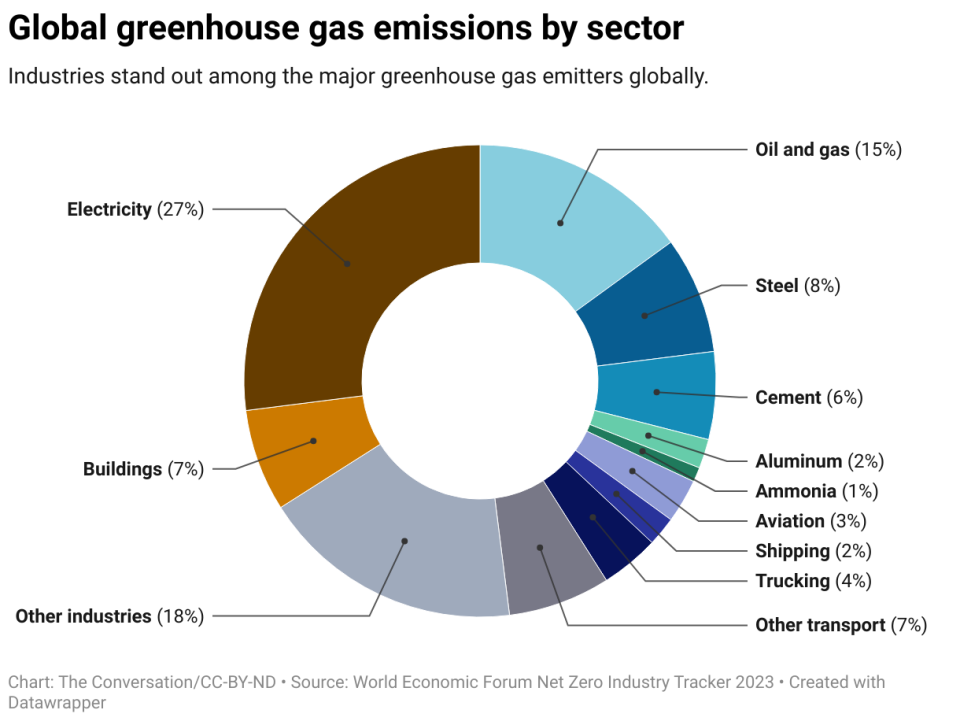As government leaders and climate negotiators gather in Dubai for the COP28 United Nations climate conference, a huge challenge looms ahead of the hearings: decarbonising the global industrial sector.
Industry has accounted for more than 30% of total greenhouse gas emissions in recent years. Considering electricity use and heat production, it is the sector that emits the largest emissions.
In order for countries to achieve their greenhouse gas emissions reduction targets, it is imperative to stop emissions from carbon-intensive industries such as steel, cement and chemicals.

There are promising technologies and innovations that could drive decarbonization in industry: green hydrogen fuel produced from clean electricity and water, energy efficiency measures in supply chains, and carbon capture, utilization and storage, to name a few.
However, these solutions have not yet been implemented at the speed and scale necessary to slow global warming.
To stay on track to reach net-zero emissions by 2050, a target adopted by many of the world’s largest economies, global industrial emissions will need to fall by 25% by 2030. This represents an extremely steep decline of 3% per year and will require a massive mobilization of money, technology and political will.
The positive news is that many countries are taking steps in the right direction. The US Inflation Reduction Act signed in 2022 includes approximately $80 billion per year for climate initiatives from 2022-27; It includes provisions to encourage clean technology deployment and encourage emissions reductions in industrial sectors.
But while efforts in developed countries are laudable, they are insufficient to achieve global decarbonization at the pace needed to keep global warming in check. Developing countries face enormous barriers to adopting low-carbon technologies, from lack of infrastructure to insufficient skills and capacity.
In a paper recently published in the journal Energy Research & Social Science, we set out a comprehensive roadmap for industry decarbonization around the world, drawing on a series of in-depth studies of specific sectors. Here are some key points.
Grow finances
First of all, financing for industrial decarbonization in the developing world needs to be radically increased. Annual investments will need to increase at least sevenfold by 2030 for the world to reach net zero emissions by mid-century.
Grants, loans, risk guarantees and equity investments through public and private organizations can help mobilize both public and private investments to achieve this goal. This financing could begin with developed countries meeting and exceeding their commitments to provide $100 billion in climate finance to developing countries each year. Developed countries bear much of the responsibility for past emissions fueling climate change.
More technology transfer
If developed countries accelerate technology transfers to the Global South, decarbonization will proceed faster. In other words, to ensure that developing economies receive the advanced technologies needed and are included in global value chains.
With the majority of industrial emissions expected to come from developing economies by mid-century, dissemination of knowledge and expertise will be critical. Partnerships between countries and companies can facilitate demonstration projects for new technologies such as green hydrogen and carbon capture in developing countries.
Enhanced job training
Investing in human capital and skills training is vital, as the transition to net zero will also require a massive workforce with new skills.
Companies and governments can collaborate to develop curricula and apprenticeship programs focused on green technologies. We need to start building this talent pipeline now for building and installing renewable energy like solar panels and devices like heat pumps. While demand for these technologies is high, one of the key constraints to their rapid growth is workforce development across geographies and technology types.
Ensuring a just transition
Another priority is a just transition for communities that have depended on fossil fuels for generations. As industries transform, some jobs will be lost while new jobs are created. Ensuring that economic and environmental benefits flow across economies will require strong government and industry programs to assist displaced workers.
Establishment of a global agreement
Finally, to progress quickly enough, a new global agreement to coordinate industrial decarbonization will likely be necessary. The agreement could establish standards, promote coordination on policies and prevent unfair competition as countries move to net-zero industries.
“Climate clubs”—groups of developed and developing countries working together to reduce emissions from specific industrial sectors—can also promote progress and technology sharing by jointly implementing decarbonization targets.
In our view, the path to net-zero emissions industries will be challenging but not impossible.
We believe that with smart policies, investments in technology and human capital, and bold leadership from countries in the Global North and Global South, decarbonizing heavy industry can be the next great climate and economic development success story.
This article is republished from The Conversation, an independent, nonprofit news organization providing facts and analysis to help you understand our complex world.
Written by: Morgan Bazilian, Colorado School of Mines; Benjamin K. Sovacool, University of Sussexand Steven Griffiths, Khalifa University.
Read more:
Morgan Bazilian is a member of the Irish Climate Council
Benjamin K. Sovacool and Steven Griffiths do not work for, consult for, own shares in, or receive funding from any company or organization that would benefit from this article, and they have disclosed no relevant affiliations other than their academic appointments.